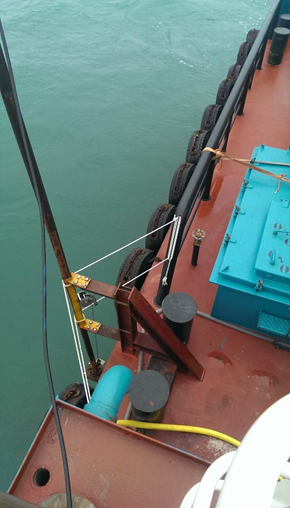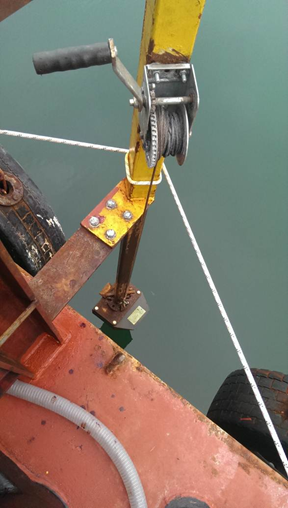First aid injury: deep cut to forearm
A member has reported an incident in which a crewman was struck and injured by an out-of-control rotating handle. The incident occurred on a small vessel during the deployment of a stand-alone echosounder. This required the use of an over the side pole to deploy the echo sounder. The crewman was lowering the echosounder pole by means of a small winch when the handle slipped from his grasp and started to rotate quickly. As he tried to grab the handle to regain control over the winch, the edge of the handle struck his forearm causing a deep cut which subsequently required seven stitches.


Our member’s investigation revealed the following:
- The requirement for an over the side pole arose due to a necessary change of vessel, only one week before mobilisation;
- There was no detailed specification in place for the required pole and winch mechanism;
- Responsibilities for the design, manufacture, installation and acceptance of the pole and winch were not clearly allocated;
- The installed winch was not suitable as it had no safety mechanism to prevent free fall when lowering;
- This hazard was not identified, as existing robust risk management procedures were not followed.
Our member drew the following lessons:
- Clear responsibilities should be defined to ensure all tasks are controlled and executed in a safe manner;
- Formal specifications for equipment should be provided to ensure that the installed equipment meets that specification. Failure to do this means there is no baseline to permit a user to determine if change management is required;
- Failure to comply with existing robust procedures can allow hazards to go undocumented;
- Handovers at shift and crew changes should be thorough, formally documented and cover all potential issues. Failure to do this can result in essential information and knowledge not being passed on.
Our member took the following corrective actions:
- Standard specifications were developed and distributed for this form of over the side pole and winch mechanism;
- Written instructions to be provided to project managers and field crew covering;
- Requirement for completion of task risk assessment and any associated method statements before project mobilisation
- Need for clear understanding and documentation of responsibilities associated with projects
- Involvement in pre-project meetings, hazard id and risk assessment (HIRA) and kick-off meetings
- Requirement for formal documented project briefing for operational personnel
- Requirement for better formal documentation of project communications
- Requirement for adherence to management of change process
- Requirement for formal documented handovers when personnel changed out
- Requirement to stop the job in the event of an unsafe condition.
Safety Event
Published: 21 January 2014
Download: IMCA SF 01/14
IMCA Safety Flashes
Submit a Report
IMCA Safety Flashes summarise key safety matters and incidents, allowing lessons to be more easily learnt for the benefit of all. The effectiveness of the IMCA Safety Flash system depends on Members sharing information and so avoiding repeat incidents. Please consider adding safetyreports@imca-int.com to your internal distribution list for safety alerts or manually submitting information on incidents you consider may be relevant. All information is anonymised or sanitised, as appropriate.
IMCA’s store terms and conditions (https://www.imca-int.com/legal-notices/terms/) apply to all downloads from IMCA’s website, including this document.
IMCA makes every effort to ensure the accuracy and reliability of the data contained in the documents it publishes, but IMCA shall not be liable for any guidance and/or recommendation and/or statement herein contained. The information contained in this document does not fulfil or replace any individual’s or Member's legal, regulatory or other duties or obligations in respect of their operations. Individuals and Members remain solely responsible for the safe, lawful and proper conduct of their operations.
